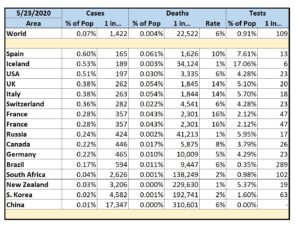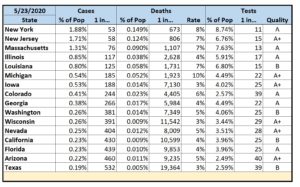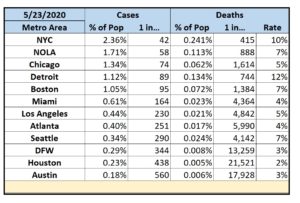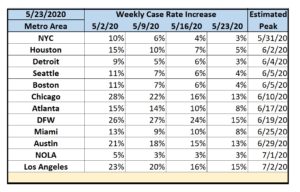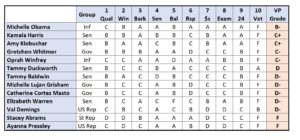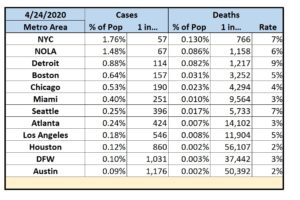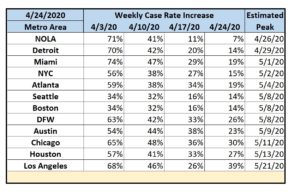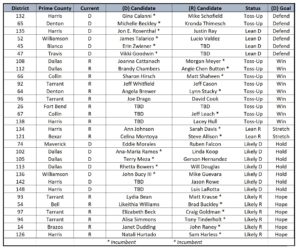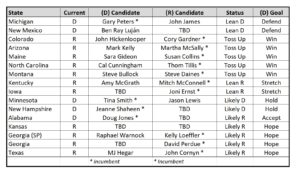Trump continues to play a very dangerous political game with the nation.
He’s been all over the map with respect to what role the federal government should play in addressing the COVID-19 pandemic. He failed to take the lead in the initial stages of the pandemic and, in fact, downplayed its significance for political purposes until it was way too late. He then pushed all responsibility to the states, forcing them to compete against each other for medical supplies. He followed that with claims of “absolute” power to override state lockdown orders, despite the 10th Amendment. After pushback from across the political spectrum, he then told each state to “call your own shots”. Yesterday, however, he was tweet-ranting against state orders: “LIBERATE MINNESOTA!” “LIBERATE MICHIGAN!” “LIBERATE VIRGINIA!” It was no coincidence that Trump’s tweets came immediately after news coverage of armed protesters outside of those state capitals.
Trump desperately wants to be seen as in charge and demands a parade whenever someone in his administration actually does their job in spite of him. However, Trump himself is not only unwilling to take any responsibility for anything, he is actively supporting open insurrection against legal orders from state governments. It is again no coincidence that the states being attacked by Trump are all led by Democratic Governors.
Many Governors – of both parties – are trying their very best to walk a very thin line between saving lives and getting their states back to work. In two of the hardest hit states, Governor Newsom of California and Governor Coumo of New York separately rolled out very sane metrics-driven plans this week. Both Democratic Governors projected optimism but neither sugar-coated the challenges ahead. The apolitical sanity of their approaches is reflected in their current popularity: Newsom has an approval rating of 83%; Coumo has an approval rating of 79%. Both had pre-pandemic approval ratings of under 50%.
The Trump administration subsequently published a set of very high-level guidelines for a three-phased approach to reopen the economy. It offered no federal assistance and was nowhere near as detailed as the previously released state plans. Although both too obvious and too optimistic, the federal guidelines were relatively sane and explicitly left interpretation of the guidelines to the states. Unfortunately, Trump didn’t read his own administration’s guidelines. If he had, he might have realized that the states he wants to “liberate” haven’t yet reached the criteria for entering even the first phase of the those guidelines.
The subsequent response from many Republican Governors has been extremely disappointing.
In my home state of Texas, Governor Abbott initially chose to let counties define their own pandemic policies, saying that what might be right for urban areas might not be right for rural areas in our rather large state. While his approach was perhaps naïve, it was at least consistent with a small government philosophy and Abbott was at least supportive of strict county-led policies of containment. However, after the federal guidelines were announced, Abbott issued orders overriding some stricter guidelines defined by numerous Texas counties.
Abbott’s sudden conversion to a state-level, open-the-flood-gates approach simply reeks of politics – particularly since his announcement was littered with irrelevant and undeserved praise for Trump. The fact that Texas has done fairly well compared to other states thus far is due to the restrictions imposed at local levels – not due to any actions by our Governor or our President. Personally, I’m less than thrilled with their interference.
Concurrently, a large gathering of idiots protested Texas business closures on the grounds of our state Capital — in open defiance of legal social distancing orders and basic common sense — and were not dispersed by state authorities. Trump also tweeted support for the protesters — presumably because any group featuring Alex Jones must be above the law.
To be sure, some Republican Governors are wisely charting their own courses in spite of Trump’s demands of the moment. Governor DeWine of Ohio has received universal praise for his decisive handling of the pandemic. While he hasn’t yet released a detailed plan for moving forward, he thanked Trump for his guidelines while rather pointedly noting that Ohio would not rush to remove the state’s current restrictions. Republican Governors Baker of Massachusetts and Hogan of Maryland have been similarly willing to do what is in the best interests of their states without regard to politics.
Whether right or wrong, in our form of government, each state is indeed empowered to take the lead within their borders. However, the federal government does have significant roles to play – and the publication of vague, unenforceable guideline documents isn’t on the list. Expressing open support for the armed defiance of state orders probably shouldn’t make the cut, either.
At this point, the one thing that the federal government can and absolutely should do is to take responsibility for the guaranteed availability of COVID-19 test kits and the supplies necessary to process those tests.
While each state would need to take the lead in the administration of such tests – and in the difficult contact tracing necessary for those tests that come back positive – each of the 50 states simply cannot be separately responsible for making sure that our country can develop and/or obtain the massive number of test kits necessary to track and contain COVID-19 cases. Until a treatment and/or a vaccine is available, our very best defense against the pandemic is data. Lots and lots of data. And the only way we can get that data is to test as many people as we can as often as we can. In particular, antibody tests can tell if someone has ever been infected with COVID-19, regardless of whether or not they ever experienced symptoms.
If we know who is currently infected, who they’ve come in contact with, and who is likely immune, we have a decent chance to control the virus without the indiscriminate social distancing currently employed. Note that Iceland’s very aggressive program has currently tested approximately 10% of their population. Their resultant data suggests that 50% of COVID-19 cases are asymptomatic – implying that if we only track those people that get visibly sick, we’ll miss half of the problem and make no progress whatsoever.
Trump, of course, has been beyond inconsistent with regards to testing:
- On March 6, Trump started by making promises he didn’t keep, stating that “Anybody that wants a test can get a test.” This obviously wasn’t true then and it isn’t true now.
- On March 13, Trump responded to a reporter who asked if he took responsibility for the lag in testing with “No, I don’t take responsibility at all.” So there.
- On March 18, Trump tried to shift blame for faulty test kits to the Obama administration claiming that “We inherited a very obsolete system.” This was patently false as the test kits in question were designed during the Trump administration.
- On March 24, Trump simply claimed success by stating that ““We now are doing more testing than anybody.” While technically correct, the statement ignores the relative size of the U.S. population. On a per capita basis, the U.S. currently ranks behind numerous countries (e.g. Germany, Italy, Canada, South Korea) in tests performed. With an estimated 3.7M tests performed in the U.S. as of this writing, we’ve tested only 1% of our population. That’s not nearly enough.
- On April 6, Trump then pivoted to a pass-the-buck stance, stating that “States can do their own testing.” Yes, but they need test kits to do that testing and the federal government is in the best position to guarantee availability.
- On April 10, Trump claimed that extensive testing just wasn’t necessary: “We’re going to do testing, but you don’t need to test 325 to 350 million people.” Actually, testing 100% of the population would be optimal and testing 1% is nowhere near sufficient.
- On April 17, Trump went back to buck passing, tweeting: “The States have to step up their TESTING!” Dude. Try to understand. The states need tests to do testing.
- On April 18, Trump inexplicably claimed that Governors simply “don’t want to use all of the capacity that we’ve created. We have tremendous capacity.” So, every Governor in every state has the ability to test more but just isn’t doing it? Sure. That makes sense.
Given the immense resources of the United States, Trump has it within his power to flood the country with test kits and processing supplies. He could negotiate with foreign countries and companies to augment national resources where necessary. He could provide coordination across labs in multiple states to speed up processing. He could guarantee that all private labs will be paid if they maximize capacity even if that capacity isn’t used. He could make tests freely and regularly available to every person in every state, even without a doctor’s order, in return for their active participation in the associated study. He could offer up the FBI and/or the military to assist the states in contact tracing. He could create a national database to pull together data from all 50 states and make an anonymized version of it freely available to every state in the nation and to every country in the world for research purposes.
So here’s my question: Who the hell is advising this guy anyway? COVID-19 testing shouldn’t be a political issue, but okay, let’s say it is one. If being seen as a hero and winning the 2020 election are the only things that matter to Trump, why is he not all over this? In this case, good policy would be great politics.
Does Trump truly believe that he can continue to play his standard misdirection game and then either quickly claim credit if things go well or blame others if they don’t? Is Trump so afraid of taking any responsibility at all that he’s willing to let people die rather than at least try to help? Is Trump so enamored with the political game that he seriously wants to keep the federal government on the sidelines so that he can try to blame Democrats when everything goes to hell? Is Trump simply too dense to understand the consequences of his actions and non-actions?
While any and all of the above are valid possibilities, I’m going with that final proposition.
